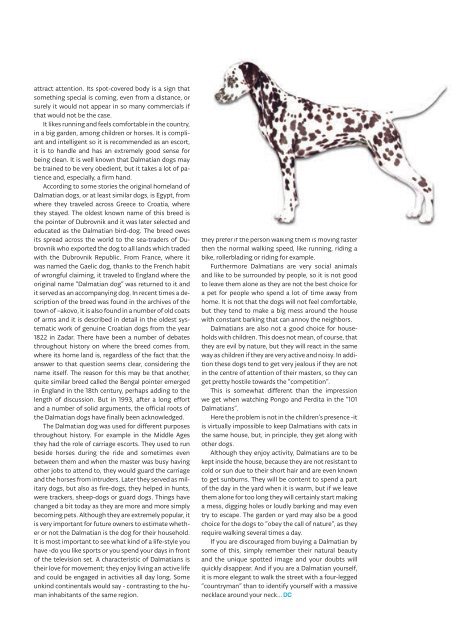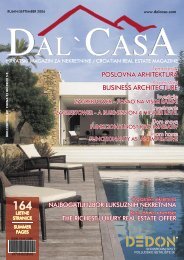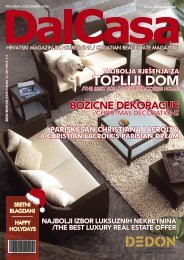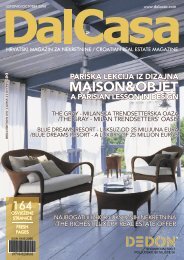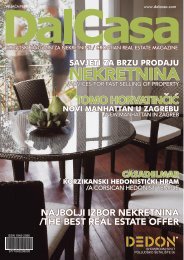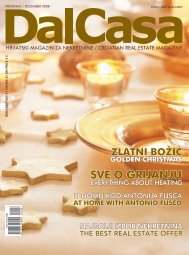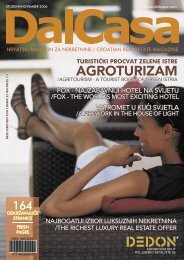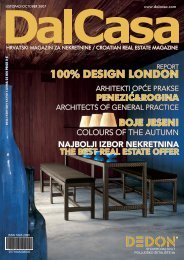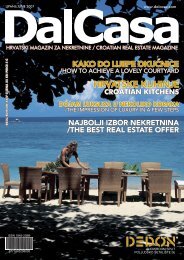Golf Park Dubrovnik - DalCasa
Golf Park Dubrovnik - DalCasa
Golf Park Dubrovnik - DalCasa
- No tags were found...
You also want an ePaper? Increase the reach of your titles
YUMPU automatically turns print PDFs into web optimized ePapers that Google loves.
attract attention. Its spot-covered body is a sign thatsomething special is coming, even from a distance, orsurely it would not appear in so many commercials ifthat would not be the case.It likes running and feels comfortable in the country,in a big garden, among children or horses. It is compliantand intelligent so it is recommended as an escort,it is to handle and has an extremely good sense forbeing clean. It is well known that Dalmatian dogs maybe trained to be very obedient, but it takes a lot of patienceand, especially, a firm hand.According to some stories the original homeland ofDalmatian dogs, or at least similar dogs, is Egypt, fromwhere they traveled across Greece to Croatia, wherethey stayed. The oldest known name of this breed isthe pointer of <strong>Dubrovnik</strong> and it was later selected andeducated as the Dalmatian bird-dog. The breed owesits spread across the world to the sea-traders of <strong>Dubrovnik</strong>who exported the dog to all lands which tradedwith the <strong>Dubrovnik</strong> Republic. From France, where itwas named the Gaelic dog, thanks to the French habitof wrongful claiming, it traveled to England where theoriginal name “Dalmatian dog” was returned to it andit served as an accompanying dog. In recent times a descriptionof the breed was found in the archives of thetown of –akovo, it is also found in a number of old coatsof arms and it is described in detail in the oldest systematicwork of genuine Croatian dogs from the year1822 in Zadar. There have been a number of debatesthroughout history on where the breed comes from,where its home land is, regardless of the fact that theanswer to that question seems clear, considering thename itself. The reason for this may be that another,quite similar breed called the Bengal pointer emergedin England in the 18th century, perhaps adding to thelength of discussion. But in 1993, after a long effortand a number of solid arguments, the official roots ofthe Dalmatian dogs have finally been acknowledged.The Dalmatian dog was used for different purposesthroughout history. For example in the Middle Agesthey had the role of carriage escorts. They used to runbeside horses during the ride and sometimes evenbetween them and when the master was busy havingother jobs to attend to, they would guard the carriageand the horses from intruders. Later they served as militarydogs, but also as fire-dogs, they helped in hunts,were trackers, sheep-dogs or guard dogs. Things havechanged a bit today as they are more and more simplybecoming pets. Although they are extremely popular, itis very important for future owners to estimate whetheror not the Dalmatian is the dog for their household.It is most important to see what kind of a life-style youhave -do you like sports or you spend your days in frontof the television set. A characteristic of Dalmatians istheir love for movement; they enjoy living an active lifeand could be engaged in activities all day long. Someunkind continentals would say - contrasting to the humaninhabitants of the same region.These dogs require a walk several times a day, butthey prefer if the person walking them is moving fasterthen the normal walking speed, like running, riding abike, rollerblading or riding for example.Furthermore Dalmatians are very social animalsand like to be surrounded by people, so it is not goodto leave them alone as they are not the best choice fora pet for people who spend a lot of time away fromhome. It is not that the dogs will not feel comfortable,but they tend to make a big mess around the housewith constant barking that can annoy the neighbors.Dalmatians are also not a good choice for householdswith children. This does not mean, of course, thatthey are evil by nature, but they will react in the sameway as children if they are very active and noisy. In additionthese dogs tend to get very jealous if they are notin the centre of attention of their masters, so they canget pretty hostile towards the “competition”.This is somewhat different than the impressionwe get when watching Pongo and Perdita in the “101Dalmatians”.Here the problem is not in the children’s presence -itis virtually impossible to keep Dalmatians with cats inthe same house, but, in principle, they get along withother dogs.Although they enjoy activity, Dalmatians are to bekept inside the house, because they are not resistant tocold or sun due to their short hair and are even knownto get sunburns. They will be content to spend a partof the day in the yard when it is warm, but if we leavethem alone for too long they will certainly start makinga mess, digging holes or loudly barking and may eventry to escape. The garden or yard may also be a goodchoice for the dogs to “obey the call of nature”, as theyrequire walking several times a day.If you are discouraged from buying a Dalmatian bysome of this, simply remember their natural beautyand the unique spotted image and your doubts willquickly disappear. And if you are a Dalmatian yourself,it is more elegant to walk the street with a four-legged“countryman” than to identify yourself with a massivenecklace around your neck...


